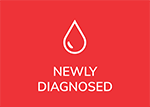This is my report from the fourth and final day of ASH 2021, the 63rd American Society of Hematology Annual Conference and Exhibition. This year is a hybrid meeting being held live in Atlanta, Georgia, and streamed virtually around the world.
Today, rather than review CLL research presented (because there was none), and rather than covering some of the oral and poster abstracts that were not part of the 18 clinical CLL oral poster presentations, I will summarize a few broad themes and hints of what the future might look like as garnered from ASH.
- Novel agents continue to work better than chemo immunotherapies such as FCR and BR. FCR in particular is associated with a higher risk of nasty second blood cancers, but the novel agents aren’t entirely problem-free. For example, the rate of atrial fibrillation and hypertension with ibrutinib continues to climb the longer the amount of time the person is on the drug.
- Fixed durations of novel drug combinations are increasingly being studied.
- Using MRD (measurable residual disease) status to guide when to stop and restart therapy is becoming an increasingly successful strategy, rather than treating for a predetermined amount of time (fixed duration) or waiting for the disease to progress in order to retreat.
- New BTKis are on the way. Zanabrutinib may offer better tolerance. And those such as pirtobrutinib (formerly LOXO-305) and MK-1026 (formerly ARQ-531) may offer a way to avoid drug resistance.
- Ibrutinib continues to offer very long-term disease control, even in high-risk patients.
- U2, which is the combination of ublituximab (an experimental anti-CD20 monoclonal antibody similar to rituximab or obinutuzumab) and umbralisib (an experimental PI3K inhibitor) is a powerful addition to ibrutinib and offers a different path to uMRD (undetectable MRD).
- Acalabrutinib is well tolerated with less atrial fibrillation than ibrutinib and offers excellent long-term disease control.
- New bispecific antibodies and new cellular therapies such as LP-118 (a novel small molecule inhibitor of Bcl-2 and Bcl-Xl) and many more new types of drugs are on their way.
- Early intervention in high-risk CLL disease is being studied.
- COVID-19 remains a killer for those with CLL, and we also have less robust responses to vaccines both in terms of antibodies and T cell production.
- Sadly, at least in the VA system, there is still a difference in the treatment received based on race. Although this is improving.
- CLL Society’s original research, with the help of readers like you who completed our survey, informed hematologists that what matters most to patients in choosing a therapy is overall survival (OS) and having future treatment options.
Overall, there were no practice-changing papers But change is in the wind with new drugs, new treatment protocols, and more individualized care based on each patient’s response to their own therapy. Over the next few months, the team at CLL Society will flesh out all these highlights to help you best navigate the ever-changing CLL treatment landscape so you can receive your best possible care.
Stay strong. We are all in this together.
Brian Koffman MDCM (retired) MS Ed (he, him, his)
Co-Founder, Executive VP, and Chief Medical Officer
CLL Society, Inc.

















